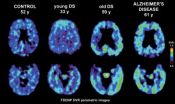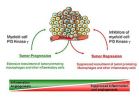(Press-News.org) PROVIDENCE, R.I. [Brown University] — A new Brown University computer analysis that predicts the effect of genetic mutations on how the body splices mRNA indicates as many as a third of disease-related mutations may be linked to splicing problems — more than double the proportion previously thought.
"Something like 85 percent of the mutations in the Human Gene Mutation Database are presumed to affect how proteins are coded, but what this work shows is that 22 percent of those are affecting the splicing process," said William Fairbrother, assistant professor of biology and senior author of a study appearing online this week in the Proceedings of the National Academy of Sciences.
Add that to the 15 percent already believed to affect splicing of mRNA, and nearly one in three mutations in the HGMD may owe at least part of their harmful results — hundreds of hereditary diseases — to the way in which they cause splicing errors.
"Splicing mutations are already known to be a large fraction, but we're saying they are even more," Fairbrother said.
Splice significance
Genes are sections of DNA sequence that provide the cell with the instructions, or code, for making the proteins that the body needs for all its functions. During this manufacturing process, useful protein coding sequences need to be cut out and reconnected — spliced — from longer sequences, much as usable movie scenes are cut from longer reels of film to make a movie.
The information necessary for the cell to join all the useful parts, or protein coding exons, together correctly is located within the sequence of that gene. Mutations that affect this splicing information are often very disruptive to gene function, causing entire exons (the scenes in a movie) to be lost from the final product. Despite this, a patient carrying a mutation that results in a faulty splicing, Fairbrother said, may eventually have a brighter outlook than a patient who has mutations in the exons themselves.
"A processing defect may be able to be detected and fixed much more easily and safely than a protein coding defect," Fairbrother said.
Other researchers, for example, have already used engineered proteins called "antisense oligoes" to interfere with errant splicing operations, he said. An error in the genetic coding for a final product protein, however, can only be addressed through difficult and risky therapies that attempt to replace a whole gene.
"There's perhaps a new type of therapy that could be directed at reducing the processing defects," Fairbrother said.
Moreover, an antisense oligo therapy that successfully fixed a splicing problem implicated in one disease could likely be easily adapted for fixing a splicing problem implicated in another disease, Fairbrother said. His group is now working with a five-year, $1.5-million National Institutes of Health grant to further investigate splicing therapies.
Predicting problems
The computer program that predicts splicing problems is a product of the multidisciplinary nature of Fairbrother's lab team. The lab is based in Brown's Department of Molecular Biology, Cell Biology, and Biochemistry, but lead author Kian Huat Lim is a computer scientist.
Lim, a graduate student, implemented a program to analyze the human genome and data on splicing operations. The idea was to look at short sequences that occur many times in the genome. The locations of these multiple occurrences told the scientists something about the function of the sequence. Sequences that help splicing often occur close to splice sites.
The program's approach is loosely akin to the analysis of patterns and variations that a team of detectives might perform when trying to stop a crime wave (e.g., if surveillance videos record the same black van driving past banks at 11 a.m., noon, and 1 p.m. prior to robberies, police would want to find that van).
The team eventually started to notice that mutations that affected splicing created new sequence motifs that changed their distribution around splice sites in distinctive ways compared to mutations that did not affect splicing. They quantified and calculated this mathematical distance from the norm.
"The bigger the distance, the more likely that it affects splicing," Lim said.
The program gave the team cues about which mutations from the HGMD to test in real lab experiments. In most cases, the computer program was correct about the effect the mutation would have on splicing. The team tested mutations associated with diseases including albinism and colorectal cancer and found that they do indeed cause splicing errors.
Lim said the program gives genetics researchers a way to triage the many mutations that pique their curiosity, to see which ones are most likely to have a clinical effect.
"Many times it is just too costly and too expensive to go into the lab and test every sequence you have," Lim said. "It is much more helpful to have a computational tool that can filter out most of your sequences to leave you with some that the tool predicts will be the interesting ones."
The team is considering making the program available via the Web later this year.
"It's a way to understand more about splicing and later understand more about diseases and how we can solve the problem," said co-author and lab technician Luciana Ferraris.
INFORMATION:
In addition to Fairbrother, Lim, and Ferraris, the paper's other authors are undergraduate Madeleine Filloux and Benjamin Raphael, assistant professor of computer science.
The National Institutes of Health funded the research.
END
A paper published online on June 13 in the Journal of Experimental Medicine (www.jem.org) identifies new gene mutations in patients with chronic lymphocytic leukemia (CLL)—a disease often associated with lack of response to chemotherapy and poor overall survival.
CLL is the most common leukemia in the Western world, but the disease varies greatly from patient to patient with regard to prognosis, survival, and disease course. In attempt to understand the genetic basis for this heterogeneity, a group led by Riccardo Dalla-Favera at Columbia University and Gianluca Gaidano ...
National Institutes of Health researchers have identified a new pathway that sets the clock for programmed aging in normal cells. The study provides insights about the interaction between a toxic protein called progerin and telomeres, which cap the ends of chromosomes like aglets, the plastic tips that bind the ends of shoelaces.
The study by researchers from the National Human Genome Research Institute (NHGRI) appears in the June 13, 2011 early online edition of the Journal of Clinical Investigation.
Telomeres wear away during cell division. When they degrade sufficiently, ...
A team of researchers, led by Emmanuel Nivet, now at the Salk Institute for Biological Studies, La Jolla, has generated data in mice that suggest that adult stem cells from immune system tissue in the smell-sensing region of the human nose (human olfactory ecto–mesenchymal stem cells [OE-MSCs]) could provide a source of cells to treat brain disorders in which nerve cells are lost or irreparably damaged.
Stem cells are considered by many to be promising candidate sources of cells for the regeneration and repair of tissues damaged by various brain disorders (including traumatic ...
EDITOR'S PICK: Sniffing out a new source of stem cells
A team of researchers, led by Emmanuel Nivet, now at the Salk Institute for Biological Studies, La Jolla, has generated data in mice that suggest that adult stem cells from immune system tissue in the smell-sensing region of the human nose (human olfactory ecto–mesenchymal stem cells [OE-MSCs]) could provide a source of cells to treat brain disorders in which nerve cells are lost or irreparably damaged.
Stem cells are considered by many to be promising candidate sources of cells for the regeneration and repair ...
In one of the first studies of its kind, UCLA researchers used a unique brain scan to assess the levels of amyloid plaques and neurofibrillary tangles — the hallmarks of Alzheimer's disease — in adults with Down syndrome.
Published in the June edition of the Archives of Neurology, the finding may offer an additional clinical tool to help diagnose dementia in adults with Down syndrome, a genetic disorder caused by the presence of a complete or partial extra copy of chromosome 21.
Adults with this disorder develop Alzheimer's-like plaque and tangle deposits early, ...
Spring flowers are opening sooner and songbirds breeding earlier in the year, but scientists know little about how climate change is affecting phenology – the timing of key biological events – in UK mammals. Now, a new study on Northumberland's iconic Chillingham cattle published in the British Ecological Society's Journal of Animal Ecology shows climate change is altering when these animals breed, and fewer calves are surviving as a result.
The team of ecologists lead by Dr Sarah Burthe of the Centre for Ecology & Hydrology were able to use the cattle to discover more ...
A new meta-analysis study, led by physician researchers at University Hospitals (UH) Case Medical Center and Case Western Reserve University School of Medicine, and to be published in the Archives of Internal Medicine (embargoed until June 13, 4 p.m. EDT), shows that three-lead cardiac pacemakers implanted in those with heart failure fail to help up to 40 percent of patients with such devices.
"These findings have significant clinical implications and impact tens of thousands of patients in the U.S.," said Ilke Sipahi, MD, Associate Director of Heart Failure and Transplantation ...
CLEVELAND – June 13, 2011 –Researchers at Case Western Reserve University School of Medicine have discovered a genetic factor that can regulate obesity-induced inflammation that contributes to chronic health problems.
If they learn to control levels of the factor in defense cells called macrophages, "We have a shot at a novel treatment for obesity and its complications, such as diabetes, heart disease and cancer," said Mukesh K. Jain, MD, Ellery Sedgwick Jr. Chair, director of the Case Cardiovascular Research Institute, professor of medicine at Case Western Reserve University ...
Cancer and chronic inflammation are partners in peril, with the latter increasing the likelihood that malignant tumors will develop, grow and spread. Researchers at the University of California, San Diego School of Medicine say they've identified a tumor inflammation trigger that is common to most, if not all, cancers. And using existing inhibitory drugs, the scientists were able to dramatically decrease primary tumor growth in animal studies and, more importantly, halt tumor progression and metastasis.
The findings appear in the June 14 issue of the journal Cancer Cell, ...
CHICAGO – Among patients who have had an ischemic stroke or transient ischemic attack (TIA), type 2 diabetes was associated with an increased risk of recurrent stroke or cardiovascular events, but metabolic syndrome was not, according to a report published Online First today by Archives of Neurology, one of the JAMA/Archives journals.
Previous research has examined the association between cardiovascular incidents and these conditions, according to background information in the article. "Type 2 diabetes mellitus is associated with increased risks of both stroke and coronary ...


